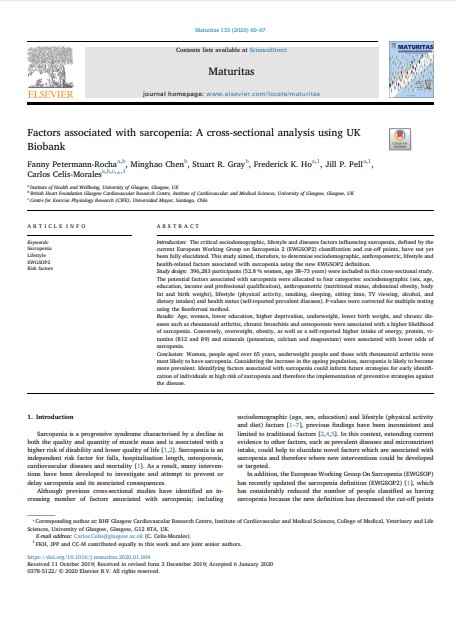Factors associated with sarcopenia: A cross-sectional analysis using UK Biobank

Fecha
2020Autor
Celis-Morales, Carlos [Univ Mayor, Ctr Exercise Physiol Res CIFE, Santiago, Chile]
Petermann-Rocha, Fanny
Chen, Minghao
Gray, Stuart R.
Ho, Frederick K.
Pell, Jill P.
Ubicación geográfica
Notas
HERRAMIENTAS
Acceda a títulos restringidos
¿Cómo descargar?Resumen
Introduction: The critical sociodemographic, lifestyle and diseases factors influencing sarcopenia, defined by the current European Working Group on Sarcopenia 2 (EWGSOP2) classification and cut-off points, have not yet been fully elucidated. This study aimed, therefore, to determine sociodemographic, anthropometric, lifestyle and health-related factors associated with sarcopenia using the new EWGSOP2 definition. Study design: 396,283 participants (52.8 % women, age 38-73 years) were included in this cross-sectional study. The potential factors associated with sarcopenia were allocated to four categories: sociodemographic (sex, age, education, income and professional qualification), anthropometric (nutritional status, abdominal obesity, body fat and birth weight), lifestyle (physical activity, smoking, sleeping, sitting time, TV viewing, alcohol, and dietary intakes) and health status (self-reported prevalent diseases). P-values were corrected for multiple testing using the Bonferroni method. Results: Age, women, lower education, higher deprivation, underweight, lower birth weight, and chronic diseases such as rheumatoid arthritis, chronic bronchitis and osteoporosis were associated with a higher likelihood of sarcopenia. Conversely, overweight, obesity, as well as a self-reported higher intake of energy, protein, vitamins (B12 and B9) and minerals (potassium, calcium and magnesium) were associated with lower odds of sarcopenia. Conclusion: Women, people aged over 65 years, underweight people and those with rheumatoid arthritis were most likely to have sarcopenia. Considering the increase in the ageing population, sarcopenia is likely to become more prevalent. Identifying factors associated with sarcopenia could inform future strategies for early identification of individuals at high risk of sarcopenia and therefore the implementation of preventive strategies against the disease.
URI
https://doi.org/10.1016/j.maturitas.2020.01.004http://repositorio.umayor.cl/xmlui/handle/sibum/6462
Coleccion/es a la/s que pertenece:
Si usted es autor(a) de este documento y NO desea que su publicación tenga acceso público en este repositorio, por favor complete el formulario aquí.